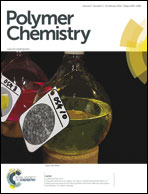Universal self-assembly of organosilanes with long alkyl groups into silicone nanofilaments†
Abstract
Recently, a new group of nanostructures called “silicone nanofilaments (SNs)” were prepared via polymerization of organosilanes with small alkyl groups. Organosilanes with long alkyl groups tend to form self-assembled monolayers and cannot form SNs because of their bulky steric hindrance. Here we report the one-step self-assembly of organosilanes with long alkyl groups into SN coatings at room temperature by using tetraethyl orthosilicate (TEOS) or tetrachlorosilane (TCS) as the molecular spacer. The SNs should grow according to a “limiting growth” mechanism via a “seeding-asymmetric growth-further growth” process. The growth of SNs could be controlled simply by the composition of the precursor and the water concentration (Cwater) in toluene. All the precursors studied can form SNs successfully under proper conditions, indicating universality of this method. The wettability of the SN coatings ranges from hydrophilic to superhydrophobic and even to superamphiphobic. Moreover, these coatings are transparent and can be easily applied onto various substrates besides the glass slide. This facile fabrication of SNs using organosilanes with long alkyl groups will shed light on their application in generating unique nanostructures besides self-assembled monolayers.


 Please wait while we load your content...
Please wait while we load your content...